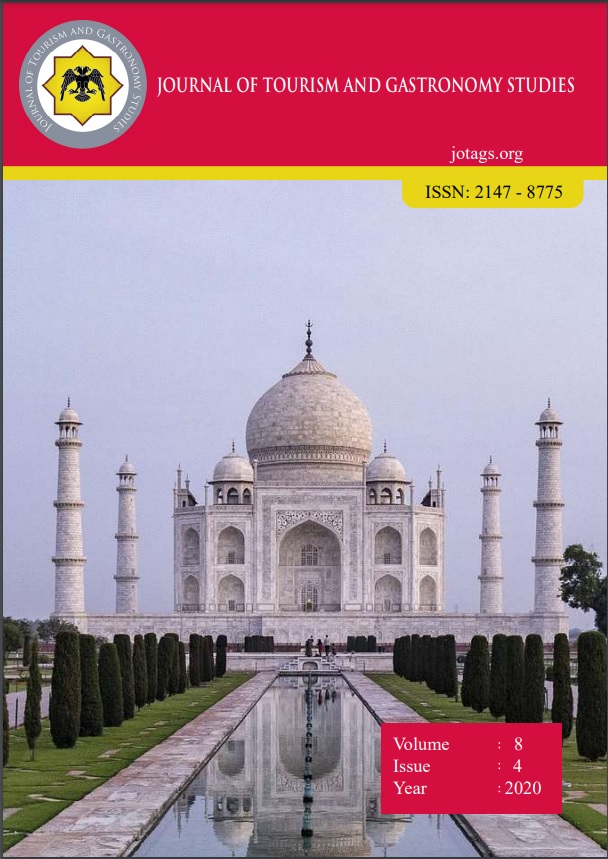Sinema Perdesinde Gastronomi Görüntüsü: Yemeğin Sosyolojik Yansımaları (Gastronomy Image on the Movie Screen: The Sociological Reflections of Food)
DOI:
https://doi.org/10.21325/jotags.2020.757Keywords:
Gastronomy, Cinema, Food sociology, Food movie, Food identityAbstract
Throughout history, food has become a part of social life as an important phenomenon that has various meanings for human beings. Communication, which is shaped around eating activities in daily life, has a unique expression in cinema, which reflects social life. Cinema, which offers a visual view of life, is very important in terms of conveying the meanings of food. The visibility of food, which has recently increased and is included in the visual culture expression, is one of the elements that make up this research. In this study, the themes of the messages to be given in films that use food as a language in cinema narration are examined. In this context, 43 motion pictures with the subject of selected food that were released and had no accessibility restrictions were analyzed using content analysis technique. One of the aims of this study is to understand the social perceptions created by the concept of food in movies in the context of the messages to be given. Another purpose of this study is to determine the social, religious and cultural reflections of films about food. Cinema has important implications for reflecting social life. In the films examined in line with the scope of this research, life styles, cultural, social and economic reflections of the society are discussed in the dining center.
References
Allen, R. (1989). Bursting bubbles: Soap opera audiences and the limits of genre. Remote Control: Television, Audiences and Cultural Power, 44-55.
Altun, A. (2020). Sinemada ete dönüştürülen hayvanın temsili ve ataerkilliğin üretimi. Kritik İletişim Çalışmaları Dergisi, 2(1), 47-59.
Anderson, C. A., Berkowitz, L., Donnerstein, E., Huesmann, L. R., Johnson, J. D., Linz, D., et al. (2003). The Influence of Media Violence on Youth. Psychological Science in the Public Interest, 4(3), 81–110.
Avakian, A. V., & Haber, B. (2005). From betty crocker to feminist food studies: Critical perspectives on women and food. Liverpool University Press.
Avcıkurt, C., & Sarıoğlan, M. (2019). Gastronomi sosyolojisine genel bakış. C. Avcıkurt ve M. Sarıoğlan (Yay. Haz.). Gastronomi olgusuna sosyolojik bakış içinde, 1-16.
Baron, C. (2006). Dinner and a movie: Analyzing food and film. Food, Culture & Society, 9(1), 93-117.
Bilici, M. V. (2007). Hollywood filmlerindeki apokaliptik temalar: sinema, popüler kültür ve din. Milel ve Nihal, 4(2), 139-161
Birch, L.L., Fisher, J.O., & Grimm-Thomas, K. (1996). The development of children’s eating habits (pp. 161-201), in H.L. Meiselman & H.J.H. Macfie (Eds.), Food choice, acceptance and consumption, Blackie Academic and Professional, London.
Boswell, P. A. (1993). Hungry in the land of plenty: Food in Hollywood films. Beyond the stars III: The material world in American popular film, 7-23.
Bourdieu, P. (1979). Distinction: A social critique of the judgment of taste. Cambridge, MA: Harvard University Press.
Bover, A. (2004). Reel food. Routledge.
Canevacci, M., & Coutinho, C. N. (1984). Antropologia Do Cinema: Do Mito À İndústria Cultural. (Eds.) Brasiliense.
Caplan, P. (Ed.). (1997). Food, health and identity. Routledge Press.
Cardello, A. (1996). Food Choice, Acceptance and Consumption (pp. 239-263), in Meiselman, H. L. (Eds.). The contextual basis for food acceptance, food choice and food ıntake: The food, the situation and the ındividual. Springer, Boston, MA.
Chandler, D. (1997): An introduction to genre theory URL http://www.aber.ac.uk/media/Documents/intgenre/intgenre.html [Erişim: 29.05.2020].
Chua, B. H. (2012). Structure, audience and soft power in east asian pop culture. (Vol. 1). Hong Kong University Press.
Civitello, L. (2011). Cuisine and culture: A history of food and people. John Wiley & Sons.
Cook, R., Hsu, C. H., & Marqua, J. (2014). Tourism: The business of hospitality and travel. Pearson.
Cunha, S. (2018). Gastronomic tourism, a differential factor. Millenium, (05), 93-98.
Çinay, H. H., & Sezerel, H. (2020). Ferzan Özpetek filmlerinde gösterge olarak yemek: Mine vaganti/serseri mayınlar. Journal of Tourism and Gastronomy Studies, 8(1), 111-136.
Douglas, M., & Isherwood, B. (1979). The world of goods. Towards an anthropology of consumption, Rev. (Eds.) London And New York: Roudledge, 1996.
Eryılmaz, Y. Ö. (2018). Yumuşak güç ve sinema. Ulusal Tez Merkezi.
Feuer, J. (1992). Genre study and television. Channels Of Discourse, Reassembled, 2, 138-60.
Fischler, C., (1988). Food, self and identity. Social Science Information 27:275-293.
Geertz, C. (1973). The interpretation of cultures (Vol. 5019). Basic books.
Germov, J., & Williams, L. (2008). Exploring the social appetite: A sociology of food and nutrition. Oxford University Press.
Goody, J. (1982). Cooking, class and cuisine. A Study in Comparative Sociology.
Kanık, İ. (2016). Gastro gösteri popüler kültür ürünlerinde yemeğin kültürel gösterisi. Ayrıntı Yayınları.
Kanık, İ. (2012). Seyirlik Yemek: Modernite’ den Postmodernite’ ye Yemeğin Sinematografisi (Doktora Tezi). Marmara Üniversitesi, Sosyal Bilimler Enstitüsü, İstanbul.
Kanık, İ. (2018). Gastro sinema. Alfa Basım Yayıncılık.
Kivela, J., & Crotts, J. (2006). Tourism and gastronomy: Gastronomy’s ınfluence on how tourists experience a destination. Journal Of Hospitality & Tourism Research, 30, pp. 354-377.
Lindenfeld, L. A. (2011). Feasts for our eyes: Viewing films on food through new lense (Eds.) Janet M. Cramer, Carlnita P.Greene & Lynn M. Walters, Food as Communication: Communication as Food, Peter Lang Publishing 3-22.
Lindenfeld, L., & Parasecoli, F. (2016). Feasting our eyes: Food films and cultural identity in the United States. Columbia University Press.
Lindenfeld, L., & Parasecoli, F. (2017). Food and cinema: An evolving relationship. The Bloomsbury Handbook of Food and Popular Culture, 27.
Lovric, B. (2016). Soft power. Journal of Chinese Cinemas, 10(1), 30-34.
Maslow, A. H. (1943). A theory of human motivation. Psychological Review, 50(4), 370.
Montanari, M. (2006). Food is culture. Columbia University Press.
Nye Jr, J. S. (2009). Soft power: The means to success ın world politics. Hachette UK.
Poole, G. (1999). Reel meals, set meals: Food in film and theatre. Currency Press.
Richards, G., & Hjalager, A. (2002). Tourism and gastronomy, Routledge.
Rocha, G. (2009). Gastronomia sensual. Civitas, Porto Alegre, V. 9, N. 2, P. 263-280, Maio-Ago.
Samancı, Ö. (2012). Avrupa’da ve Türkiye’de yemek tarihçiliğine kısa bir bakış. Yemekte Tarih Var Yemek Kültürü ve Tarihçiliği.
Stam, R. (2000). Beyond fidelity: The dialogics of adaptation. Film Adaptation, 54-76.
Strauss, A., & Corbin, J. (1990). Basics of qualitative research. Sage Publications.
Strauss, C. L. (1974). Structural anthropology. Persona & Derecho, 1, 571.
Tutar, C., & Durukan, D. (2020). Gastronomi kültürünün inşası ve dönüşümünde televizyon: Masterchef Türkiye ve The Taste Türkiye programları örneği. İstanbul Üniversitesi Sosyoloji Dergisi, 40(1), 339-364.
Türkiye Diyanet Vakfı. İslam ansiklopedisi, (1997). Sayı 15, İstanbul: İsam Yayıncılık, s. 278-282. Erişim Tarihi: 20.06.2020.
Yıldırım, A., & Şimşek, H. (2016). Sosyal bilimlerde nitel araştırma yöntemleri. 10. Baskı. Ankara: Seçkin Yayıncılık.
Zainal, A., Zali, A. N., & Kassim, M. N. (2010). Malaysian gastronomy routes as a tourist destination. Journal of Tourism, Hospitality & Culinary Arts, 2(1), 1-10.
Downloads
Published
How to Cite
Issue
Section
License
Copyright (c) 2023 Journal of Tourism & Gastronomy Studies

This work is licensed under a Creative Commons Attribution-NonCommercial 4.0 International License.








